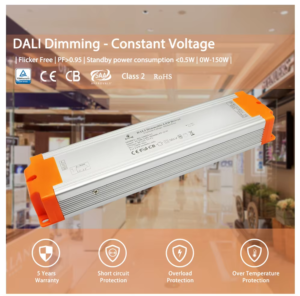TRIAC-himmennykset ovat avainasemassa nykyaikaisissa valaistusjärjestelmissä. Ne tarjoavat yksinkertaisen ja luotettavan tavan ohjata valoa. Niiden toiminnan ymmärtäminen voi auttaa sinua tekemään tietoon perustuvia päätöksiä kotisi tai toimistosi valaistuksesta. Tämä opas käsittelee TRIAC-himmennin. Se kattaa niiden perusperiaatteet ja edut. Siinä myös verrataan niitä muihin himmennystekniikoihin.
TRIAC-himmennin on elektroninen laite. Sitä käytetään vaiheittaisessa himmennyksessä hehkulamppujen, halogeenivalojen ja joidenkin LED-valojen kirkkauden säätämiseen. Se ohjaa valonlähteeseen syötettävää tehoa, mikä mahdollistaa tasaisen ja luotettavan himmennyksen. TRIAC on lyhenne sanoista "Triode for Alternating Current" (vaihtovirran triodi), joka viittaa elektroniseen komponenttiin, joka hallitsee virran kulkua.
Let’s dive deeper into TRIAC dimmers. We will explore their types, how they work, and how they compare to other dimming technologies. Knowing these details will help you make informed decisions. It's about lighting controls in different settings.
Mitä ovat TRIAC-himmenninlaitteet?
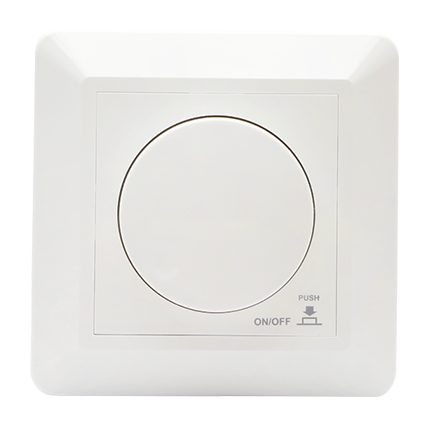
TRIAC dimmers are a type of phase-cut dimmer. They control light brightness by adjusting the power sent to the light. "TRIAC" stands for "Triode for Alternating Current." It is a semiconductor that can control current in both directions. This makes it ideal for AC circuits. TRIAC dimmers are most commonly used with incandescent, halogen, and some LED lighting. They work by chopping a portion of the AC voltage waveform, which reduces the power reaching the light bulb, thereby dimming the light.
Näitä himmentimiä arvostetaan erityisesti niiden yksinkertaisuuden ja kustannustehokkuuden vuoksi. Niitä on laajalti saatavilla ja ne on helppo asentaa. Tämän vuoksi ne ovat suosittuja kodin valaistuksessa. Niiden tehokkuus voi kuitenkin vaihdella käytetyn hehkulampun tyypin mukaan. Ne toimivat hyvin esimerkiksi hehku- ja halogeenivalojen kanssa. Niillä voi kuitenkin olla ongelmia ledien kanssa. Tämä voi aiheuttaa ongelmia, kuten välkkymistä tai surinaa. Näistä haasteista huolimatta TRIAC-himmentimet ovat edelleen perusasioita valaistuksen ohjauksessa. Tämä pätee erityisesti niille, jotka pitävät yksinkertaisuutta ja edullisuutta tärkeinä.
Himmenninkytkimien tyypit
Himmenninkytkimiä on saatavana useita eri tyyppejä, joilla kullakin on oma menetelmänsä valon voimakkuuden säätöön. Näiden erojen ymmärtäminen voi auttaa sinua valitsemaan tarpeisiisi parhaiten sopivan himmentimen. Yleisimpiä tyyppejä ovat mm:
- TRIAC-himmennin: Nämä ovat yleisimmin käytettyjä himmentimiä hehku- ja halogeenivaloille. Ne toimivat leikkaamalla vaihtojännitteen vaiheen, mikä tarkoittaa, että ne säätelevät kirkkautta katkaisemalla osan sähköaallosta. Tämä tekee niistä yksinkertaisia ja kustannustehokkaita, mutta mahdollisesti ongelmallisia tiettyjen LED-lamppujen kanssa.
- PWM (pulssinleveysmodulaatio) himmentimet: PWM-himmennin ohjaa valojen kirkkautta kytkemällä ne nopeasti päälle ja pois päältä. Valo näyttää himmeämmältä, koska se on enemmän aikaa pois päältä kuin päällä. Tämä menetelmä on erityisen tehokas LED-valoille, sillä se mahdollistaa tasaisen himmennyksen ilman välkkymistä. PWM-himmentimet ovat kuitenkin monimutkaisempia ja yleensä kalliimpia kuin TRIAC-himmentimet.
- 0-10V himmentimet: Näitä käytetään pääasiassa kaupallisissa valaistussovelluksissa. Ne lähettävät pienjännitesignaalin (0-10 volttia) valaisimeen sen kirkkauden säätöä varten. 0-10V-himmennyksen yksinkertaisuus ja tarkkuus tekevät siitä ihanteellisen ympäristöihin, joissa tarvitaan tarkkaa valonohjausta, mutta se edellyttää yhteensopivia valaisimia ja voi olla kalliimpi toteuttaa.

Jokaisella himmennintyypillä on omat etunsa ja mahdolliset haittansa. Asuinkäyttöön TRIAC-himmentimet ovat usein riittäviä ja taloudellisia. Sitä vastoin PWM- ja 0-10V-himmentimet ovat parempia sovelluksiin, joissa tarvitaan hienompaa ohjausta ja yhteensopivuutta nykyaikaisten valojen kanssa.
Miten TRIAC-himmennin toimii?
TRIAC-himmennin toimii leikkaamalla vaihtojännitteen aaltomuodon vaiheen. Tähän prosessiin kuuluu useita vaiheita tasaisen ja tehokkaan himmennyksen varmistamiseksi:
- Vaiheen leikkaus: Himmennin katkaisee osan vaihtovirran siniaallosta. Vaihtelemalla aallon leikkauskohtaa himmennin voi säätää, kuinka paljon virtaa lamppuun tulee. Tätä kutsutaan vaiheen katkaisuksi, ja se voidaan tehdä aaltomuodon alussa (etureuna) tai lopussa (takareuna).
- TRIAC-toiminta: TRIAC laukaistaan tietyssä vaiheessa vaihtosykliä. Kun se on laukaistu, se antaa virran kulkea lampun läpi, kunnes vaihtovirran aaltomuodon seuraava nollakohta ylittyy. Tämän laukaisun ajoitus määrittää valon kirkkauden.
- Kirkkauden säätö: Säätämällä laukaisupistettä himmennin voi säätää kirkkautta. Mitä aikaisemmin TRIAC käynnistyy syklin aikana, sitä kirkkaampi valo on. Sitä vastoin mitä myöhemmin se laukaistaan, sitä himmeämpi valo on. Tämä menetelmä tarjoaa yksinkertaisen tavan säätää valaistuksen tasoa. Se edellyttää kuitenkin yhteensopivia hehkulamppuja, jotta välkkymisen kaltaiset ongelmat voidaan välttää.
- Yhteensopivuus hehkulamppujen kanssa: Kaikkia hehkulamppuja ei ole suunniteltu toimimaan TRIAC-himmenninten kanssa. Hehkulamput ja halogeenilamput toimivat yleensä hyvin. Mutta LED-lamput voivat olla vaikeita niiden erilaisten sähköominaisuuksien vuoksi. Jotkin nykyaikaiset ledit on suunniteltu yhteensopiviksi TRIAC-himmentimien kanssa, mutta on tärkeää tarkistaa tekniset tiedot ennen käyttöä.
TRIAC-himmenninlaitteissa on 2 himmennystyyppiä, kuten eteenpäin suuntautuva ja käänteinen vaihehimmennys.
Eteenpäin suuntautuva vaiheen himmennys
Eteenpäin suuntautuva vaihehimmennys, joka tunnetaan myös nimellä leading-edge-himmennys, on yleisin asuinsovelluksissa käytetty vaihehimmennystyyppi. Tämä menetelmä toimii leikkaamalla vaihtovirran siniaallon etuosan, mikä vähentää tehokkaasti valonlähteeseen syötettävää tehoa.
Miten se toimii:
- Alkuperäinen leikkaus: TRIAC-himmennin katkaisee vaihtovirran siniaallon etureunan. TRIAC pysyy pois päältä, kunnes jännite saavuttaa tietyn kynnysarvon.
- Trigger Point: Kun kynnysarvo on saavutettu, TRIAC kytkeytyy päälle ja antaa virran kulkea puolijakson loppuun asti.
- Toisto: Prosessi toistuu jokaisessa vaihtovirtajaksossa, jolloin valaisimelle syötetyn tehon määrää ohjataan ja valoa himmennetään.
Edut:
- Yhteensopivuus: Toimii hyvin hehku- ja halogeenilamppujen kanssa, jotka ovat yleisiä monissa kotitalouksissa.
- Yksinkertaisuus: Eteenpäin suuntautuvan vaiheen himmentimet ovat yleensä yksinkertaisempia ja kustannustehokkaampia valmistaa.
Haitat:
- LED-kysymykset: Saattaa aiheuttaa välkyntää tai surinaa, kun käytetään LED-valoja, joita ei ole erityisesti suunniteltu etuvaiheen himmennykseen.
- Rajoitettu valvonta: Himmennys ei ole yhtä tasainen kuin käänteisen vaiheen himmentimissä, erityisesti pienemmillä kirkkaustasoilla.
Käänteisvaiheen himmennys
Käänteisvaiheen himmennys, joka tunnetaan myös nimellä jälkikäteen tapahtuva himmennys, on yleisemmin käytössä nykyaikaisissa valaistustekniikoissa, kuten LEDeissä ja tietyntyyppisissä pienloistelampuissa (CFL). Tämä menetelmä toimii leikkaamalla vaihtovirran siniaallon loppuosan.
Miten se toimii:
- Alkuperäinen täysi aalto: Himmennin päästää aluksi läpi koko vaihtovirran siniaallon.
- Katkaisupiste: Sen jälkeen se katkaisee siniaallon takareunan, mikä vähentää valonlähteeseen syötettävää tehoa.
- Hallittu sammutus: Himmennin sammuttaa virran kulun vaihtovirtajakson loppua kohti.
Edut:
- Tasainen himmennys: Tarjoaa tasaisemmat himmennyssiirtymät, mikä on erityisen hyödyllistä LED-valoille.
- Vähennetty melu: Aiheuttaa tyypillisesti vähemmän surinaa ja välkyntää LEDeissä verrattuna eteenpäin suuntautuviin himmenninlaitteisiin.
Haitat:
- Kustannukset: Monimutkaisempi ja yleensä kalliimpi kuin eteenpäin suuntautuvat himmenninlaitteet.
- Yhteensopivuus: Vaikka LEDit ovatkin parempia, ne eivät välttämättä ole yhteensopivia kaikkien perinteisten hehkulamppujen tai halogeenilamppujen kanssa.
Eteenpäin ja taaksepäin suuntautuvan vaiheen himmennyksen erojen ymmärtäminen voi auttaa sinua valitsemaan parhaan himmennyskytkimen. Se sopii juuri sinun valaistustarpeisiisi.
Nämä periaatteet voivat auttaa sinua vianmäärityksessä ja varmistaa, että valaistusjärjestelmäsi toimii tarkoitetulla tavalla. TRIAC-himmennin tarjoaa luotettavan tavan säätää valaistuksen tasoa. Niiden suorituskyky voi kuitenkin riippua käytettyjen lamppujen erityisominaisuuksista.
TRIAC-himmennin hyvät ja huonot puolet
Plussaa:
- Kustannustehokas: TRIAC-himmentimet ovat yleensä edullisia ja laajalti saatavilla. Ne tarjoavat edullisen tavan säätää valon voimakkuutta. Tämän ansiosta ne ovat helposti saatavilla useimmissa kodeissa.
- Yhteensopivuus: Ne toimivat hyvin hehku- ja halogeenivalojen kanssa. Nämä lamput reagoivat ennustettavasti TRIAC-himmenninlaitteisiin. TRIAC-himmentimissä käytetään vaiheen katkaisumenetelmää. Lamput himmenevät tasaisesti ja johdonmukaisesti.
- Yksinkertaisuus: Helppo asentaa ja käyttää. TRIAC-himmenninten rakenne on yksinkertainen. Tämän vuoksi ne ovat suosittuja kodinomistajien keskuudessa. He haluavat lisätä himmennyksen ilman monimutkaisia asetuksia.
Miinukset:
- Yhteensopivuusongelmat LEDien kanssa: Kaikki LED-valot eivät ole yhteensopivia TRIAC-himmenninten kanssa, mikä voi johtaa välkkymiseen tai surinaan. LED-tekniikka toimii eri tavalla kuin hehku- ja halogeenilamput, mikä aiheuttaa joskus suorituskykyongelmia, kun se yhdistetään TRIAC-himmenninlaitteisiin.
- Rajoitettu himmennysalue: Ne eivät välttämättä tarjoa tasaista himmennystä tietyntyyppisten lamppujen kanssa. Joidenkin valojen kirkkaus saattaa muuttua yhtäkkiä, eikä siirtyminen tapahdu tasaisesti. Tämä tapahtuu alhaisemmilla valaistustasoilla.
- Lämmöntuotanto: TRIAC-himmennin voi tuottaa lämpöä, varsinkin kun sitä käytetään suuritehoisten lamppujen kanssa. Tämä voi johtaa tehottomuuteen ja joissakin tapauksissa himmennin tai lampun käyttöiän lyhenemiseen.
Kaiken kaikkiaan TRIAC-himmennin tarjoaa käytännöllisen ratkaisun moniin valaistussovelluksiin. Niissä on kuitenkin harkittava huolellisesti käytettäviä lampputyyppejä ja mahdollisia yhteensopivuusongelmia. Ne ovat yksinkertaisia ja halpoja, joten ne ovat suosittuja. Uudemmat tekniikat saattavat kuitenkin toimia paremmin nykyaikaisessa valaistuksessa.
Kuluttajaluokan himmennysratkaisut - TRIAC vs. PWM vs. 0-10v
Himmennysratkaisua valittaessa on tärkeää ymmärtää TRIAC-, PWM- ja 0-10V-himmennysten erot. Kullakin tekniikalla on omat etunsa, ja ne soveltuvat eri sovelluksiin:
TRIAC-himmennin:
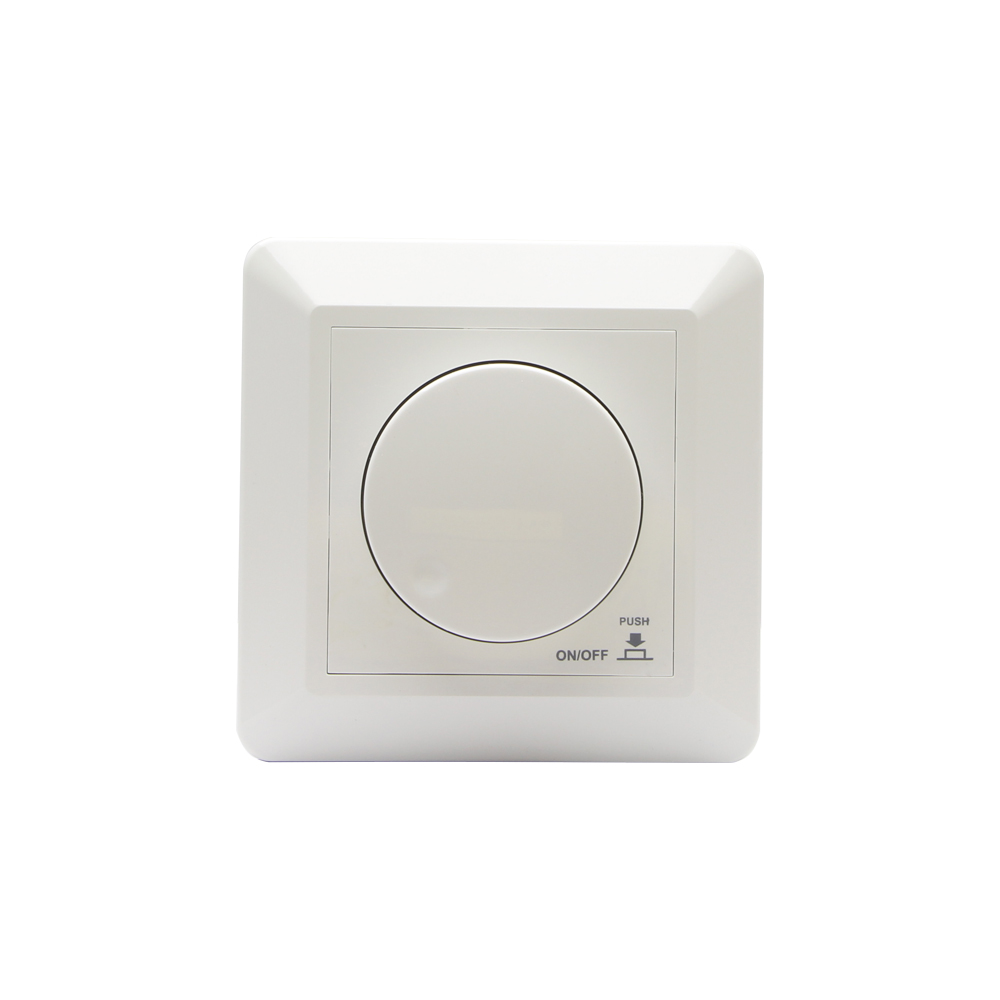
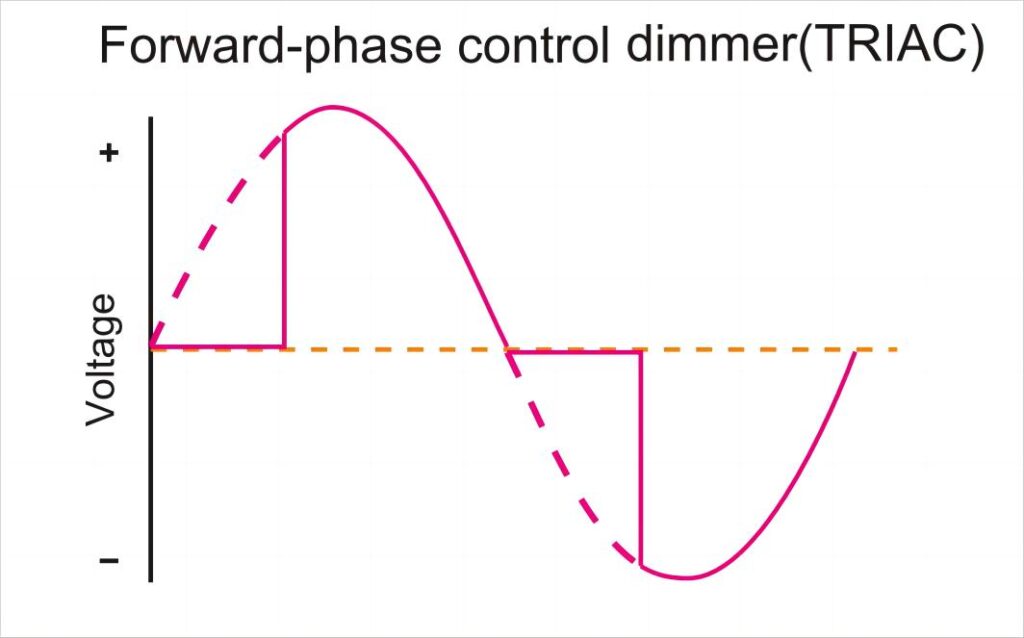
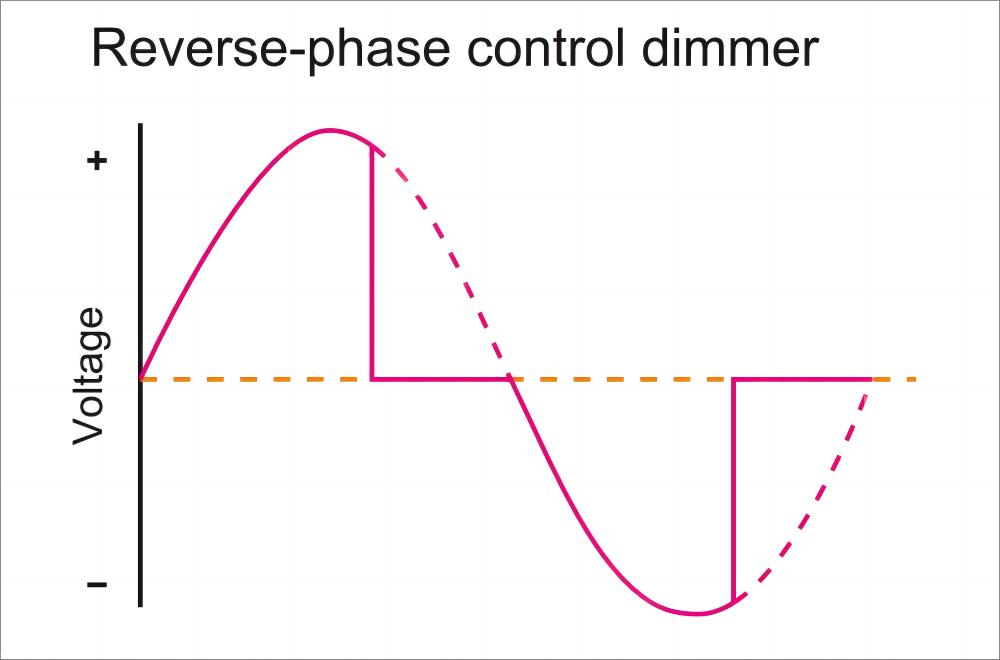
- Sopii parhaiten hehku- ja halogeenivaloille. Nämä perinteiset lamput sopivat hyvin TRIAC-himmenninten käyttämään vaiheiden katkaisumenetelmään. Se tarjoaa luotettavan ja yksinkertaisen himmennysratkaisun.
- Saattaa olla yhteensopivuusongelmia LEDien kanssa. Jotkin LEDit on suunniteltu toimimaan TRIAC-himmenninten kanssa, mutta toiset saattavat välkkyä tai vilkkua, koska ne käsittelevät sähkövirtaa eri tavoin.
- Yksinkertainen ja kustannustehokas. TRIAC-himmennin on yleinen ja helppo asentaa. Ne ovat suosittu valinta koteihin. Kodit välittävät budjetista ja yksinkertaisuudesta.
PWM-himmennin:

- Sopii LED-valoille. PWM-himmennin säätelee kirkkautta kytkemällä valon nopeasti päälle ja pois päältä, ja tämä menetelmä toimii hyvin LED-lampuissa käytettävien elektronisten ohjainten kanssa.
- Tarjoaa tasaisen himmennyksen. Nopea kytkentä mahdollistaa valon voimakkuuden hienosäädön. Tuloksena on tasainen himmennys ilman TRIAC-himmenninten välkkymistä.
- Monimutkaisempi ja kalliimpi kuin TRIAC-himmennin. PWM-himmennyksen taustalla oleva tekniikka on kehittyneempää, mikä johtaa korkeampiin kustannuksiin ja monimutkaisempiin asennusvaatimuksiin. Parempi suorituskyky voi kuitenkin korvata nämä haitat, jos käyttäjä asettaa laadun etusijalle.
0-10V himmentimet:
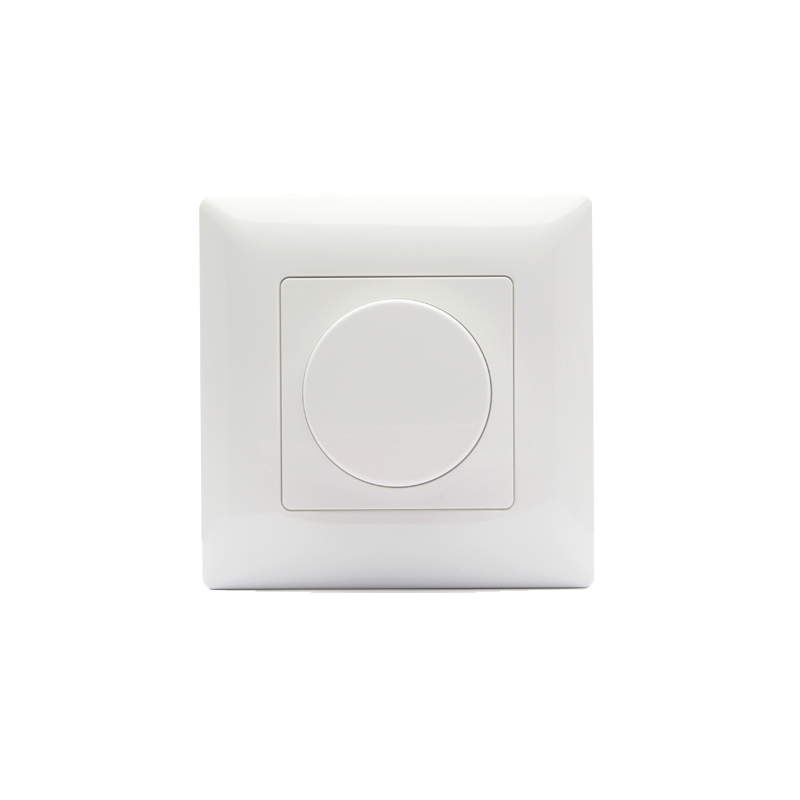
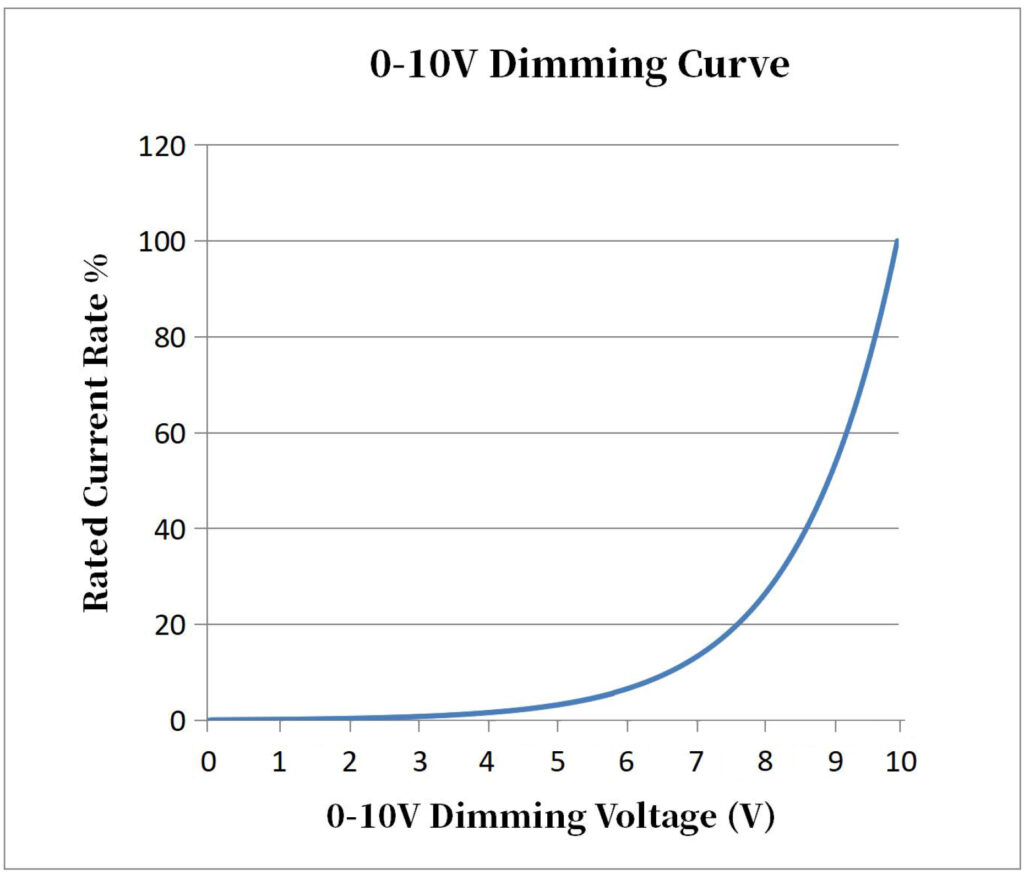
- Ihanteellinen kaupallisiin valaistussovelluksiin. 0-10V-standardi mahdollistaa valaistuksen tarkan hallinnan, joten se soveltuu ympäristöihin, joissa tarvitaan erityisiä valaistustasoja.
- Valon voimakkuuden tarkka säätö. Tämä himmennys on hyvin säädettävissä. Se mahdollistaa tarkat asetukset. Näillä asetuksilla voidaan parantaa sekä toimintaa että energiatehokkuutta kaupallisissa tiloissa.
- Vaatii yhteensopivat valaisimet ja johdotuksen. 0-10V-himmennysjärjestelmän käyttöönotto voi olla kalliimpaa ja monimutkaisempaa, koska tarvitaan erikoisvalaisimia ja lisäjohdotuksia. Ohjauksen ja joustavuuden tuomat edut ovat kuitenkin usein suuremmat kuin nämä alkuasennuskustannukset.
Choosing the right dimming technology depends on your lighting's needs. TRIAC dimmers are simple and affordable. PWM dimmers work well with LEDs. 0-10V dimmers offer precise control for commercial use.
Teollisuusluokan vaihtoehtoja TRIAC Dimmerille
Teollisuussovelluksissa tarvitaan kestävämpiä himmenninratkaisuja. Nämä vaihtoehdot TRIAC-himmenninlaitteille tarjoavat paremman ohjauksen ja joustavuuden teollisuusympäristöjen erityistarpeisiin:
- DALI (Digital Addressable Lighting Interface): DALI on valaistuksen ohjaukseen käytettävä digitaalinen protokolla, joka mahdollistaa yksittäisten valojen tai valoryhmien tarkan ja joustavan hallinnan. DALI-järjestelmillä voidaan ohjata monia valaistukseen liittyviä asioita. Ne voivat ohjata voimakkuutta, väriä ja ajoitusta. Näin ne hallitsevat kattavasti suuria valaistusasetelmia. Tämä tekee niistä ihanteellisia tehtaisiin. Tehtaissa tarvitaan tarkkaa valaistuksen ohjausta tuottavuuden, turvallisuuden ja energiatehokkuuden kannalta.
- DMX (digitaalinen multipleksi): DMX-järjestelmiä käytetään yleisesti näyttämövalaistuksessa ja teatterisovelluksissa, ja ne tarjoavat korkean tason ohjausta ja mukauttamista. Niillä voidaan ohjata monia valoja kerralla. Näin niillä voidaan luoda monimutkaisia valaistuskohtauksia ja -efektejä. Teollisuudessa DMX:llä voidaan ohjata monimutkaista valaistusta. Tämä on hyödyllistä varastoissa, tehtaissa ja ulkovalaistuksessa.
- Älykkäät valaistusjärjestelmät: Näissä järjestelmissä käytetään langatonta tekniikkaa ja älykkäitä ohjausjärjestelmiä edistykselliseen valaistuksen ohjaukseen ja automaatioon. Älykkäät valaistusjärjestelmät voidaan liittää rakennuksen hallintajärjestelmiin. Ne tarjoavat kauko-ohjausta, aikataulutusta ja energiaseurantaa. Ne ovat erityisen hyödyllisiä teollisuusympäristöissä, joissa joustavuus ja skaalautuvuus ovat tärkeitä. Älykkäät järjestelmät voivat mukautua muuttuviin tarpeisiin. Ne voivat tarjota tietoon perustuvia tietoja valaistuksen parantamiseksi.
Kukin näistä teollisuustason ratkaisuista tarjoaa ainutlaatuisia etuja. Ne on räätälöity suurten ja monimutkaisten valaistusasennusten tarpeisiin. Oikean järjestelmän valinta auttaa teollisuuslaitoksia. Sen avulla ne voivat saavuttaa paremman tehokkuuden, joustavuuden ja valaistuksen hallinnan.
Mikä himmennysratkaisu on paras valoille?
Oikean himmennysratkaisun valinta riippuu monista tekijöistä. Näitä ovat muun muassa käyttämäsi valaisintyyppi, budjettisi ja tarpeesi. Seuraavassa on joitakin ohjeita, jotka auttavat sinua päättämään:
- Kotikäyttöön: TRIAC-himmentimet ovat hyvä valinta hehku- ja halogeenivaloille niiden yksinkertaisuuden ja edullisuuden vuoksi. Varmista, että valitset LED-valoille yhteensopivan TRIAC-himmentimen tai harkitse PWM-himmentimen käyttöä paremman suorituskyvyn saavuttamiseksi. Jos valaistusasetuksesi on yksinkertainen, TRIAC-himennin voi olla helppo ja kustannustehokas ratkaisu.
- Kaupalliseen käyttöön: 0-10V himmentimet ovat ihanteellisia kaupallisiin valaistussovelluksiin, joissa tarvitaan tarkkaa ohjausta ja johdonmukaisuutta. Ne tarjoavat tasaisen himmennyksen ja kestävät suurten liiketilojen vaatimukset. Nämä himmentimet sopivat erinomaisesti toimistoihin ja myymälätiloihin. Ne soveltuvat myös muihin tiloihin, joissa tarkka valaistus on avainasemassa sekä toiminnan että energiansäästön kannalta.
- Teolliseen käyttöön: Harkitse DALI- tai DMX-järjestelmien käyttöä kehittyneeseen ohjaukseen ja joustavuuteen. Nämä järjestelmät mahdollistavat suurten, monimutkaisten valaistusasetelmien täydellisen hallinnan. Ne soveltuvat hyvin teollisuuslaitoksiin, joissa tarvitaan yksityiskohtaista valaistuksen hallintaa. Myös älykkäät valaistusjärjestelmät voivat olla hyvä valinta. Ne tarjoavat kauko-ohjausta ja automaatiota. Nämä ominaisuudet parantavat toiminnan tehokkuutta.
Picking the right dimmer makes sure your lighting works well. It meets your environment's needs. Consider the light type, the setting, and your control needs. This will let you choose well and boost both function and efficiency.
Päätelmä
TRIAC-himmenninten ymmärtäminen voi auttaa sinua valitsemaan parhaan valaistuksen ohjauksen. Niiden avulla voit löytää ympäristöönne sopivan säätimen. Himmenninkytkimet ovat avainasemassa koti- ja teollisuuskäytössä. Oikean valitseminen takaa parhaan valaistuksen ja energiatehokkuuden. Ota huomioon käyttämäsi valaisintyyppi ja tarpeesi. Sen jälkeen voit tehdä älykkään valinnan, joka parantaa valaistustasi. Oikea himmennin parantaa tilasi tunnelmaa ja käytettävyyttä. Se myös säästää energiaa ja auttaa valaistustasi kestämään.
Hanki luokkansa paras TRIAC-himmennin boqi
Jos etsit monipuolista ja tehokasta himmenninratkaisua, harkitse BQ-TTLDIM himmennin Boqilta. Tämä innovatiivinen himmennin tarjoaa useita ominaisuuksia, jotka on suunniteltu parantamaan valaistuskokemustasi:
- Pyörivä himmennys: Säädä kirkkautta helposti pyörivällä paneelilla. Se antaa intuitiivisen hallinnan valaistukselle.
- Leading Edge tai Trailing Edge: Tämä himmennin tukee sekä etu- että takareunan himmennystä. Se toimii monenlaisten lamppujen kanssa, mukaan lukien himmennettävät LED-lamput, vanhat hehkulamput ja halogeenilamput.
- Langaton kaukosäädin: Nauti valojen säätämisen mukavuudesta etänä Boqin 2,4G-himmennyskaukosäätimellä. Se lisää modernia mukavuutta valaistusasetuksiisi.
- Koe tasainen himmennys: Siinä on 256 tasoa, ja sen vaihteluväli on 0-100%. Tämä mahdollistaa valaistuksen tarkan hallinnan.
- Laaja tulojännite: Himmennin tukee laajaa tulojännitealuetta AC100-240V, joten se soveltuu erilaisiin sovelluksiin maailmanlaajuisesti.
- Kehittynyt suojaus: Sisäänrakennettu ylikuumenemis- ja ylikuormitussuoja takaa turvallisen toiminnan ja pidentää himmennysjärjestelmän käyttöikää. Himmennin palautuu automaattisesti ylikuormitustilanteista.
- Kestävyys: Durability is key. The BQ-TTLDIM dimmer has a 5-year warranty. It offers reliability and peace of mind. It ensures you'll be happy with your purchase for a long time.

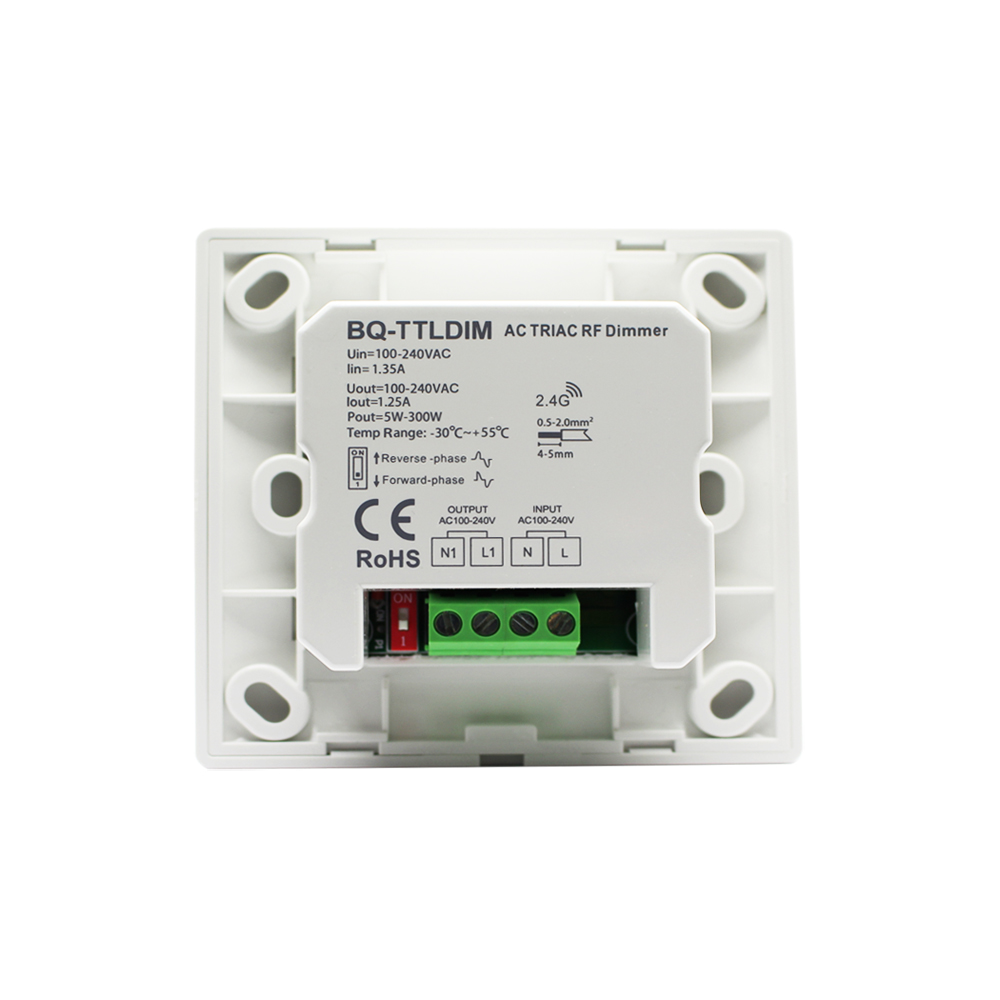
Get the BQ-TTLDIM dimmer. It will upgrade your lighting control. You'll get better functionality, convenience, and efficiency at home or work.




